|
|
 |
|
Calanoida ( Order ) |
|
|
|
Lucicutiidae ( Family ) |
|
|
|
Lucicutia ( Genus ) |
|
|
| |
Lucicutia longicornis (Giesbrecht, 1889) (F,M) | |
| | | | | | | Syn.: | Leuckartia longicornis Giesbrecht,1889; 1892 (p.359, 367, 773, figs.F,M) | | | | Ref.: | | | Giesbrecht & Schmeil, 1898 (p.111, Rem. F,M); Wolfenden, 1911 (p.323); Rose, 1933 a (p.197, figs.F,M); Jespersen, 1934 (p.104, Rem.); Lysholm & al., 1945 (p.35); Sewell, 1948 (p.503, 558, 563, 567, 569); Chiba & al., 1957 (p.310); 1957 a (p.11); Hülsemann, 1966 (p.721, figs.F,M); Vinogradov, 1968 (1970) (p.261); Björnberg & al., 1981 (p.648, F,M); Ali-Khan & Ali-Khan, 1982 (p.269, figs.F); Bradford-Grieve & al., 1999 (p.883, 945, figs.F,M); Boxshall & Halsey, 2004 (p.132: F; p.134: M; p.135: Rem.); Vives & Shmeleva, 2007 (p.337, figs.F,M, Rem.) | 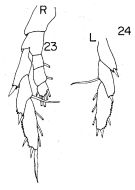 Issued from : K. Hülsemann in Bull. Mar. Sc., 1966, 16 (4). [p.710, Figs.23-24]. Female: 23, right P1; 24, exopod of left P5. Nota: In all females examined the terminal spine of left P5 was very short, whereas the same spine of right P5 was well developed.
|
 Issued from : K. Hülsemann in Bull. Mar. Sc., 1966, 16 (4). [p.718, Fig.66]. Female: 66, urosome (dorsal).
|
 Issued from : K. Hülsemann in Bull. Mar. Sc., 1966, 16 (4). [p.724, Fig.104]. Male: 104, P5.
|
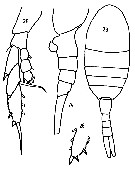 issued from : S. Ali-Khan & J. Ali-Khan in Crustaceana, 1982, 43 (3). [p;306, Figs.23-26]. Female (from 24°09'N, 64°27'E): 23, habitus (dorsal); 24, urosome (lateral, left side); 25, right P5; 26, terminal portion of left P5.
|
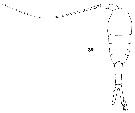 Issued from : W. Giesbrecht in Systematik und Faunistik der Pelagischen Copepoden des Golfes von Neapel und der angrenzenden Meeres-Abschnitte. - Fauna Flora Golf. Neapel, 1892. Atlas von 54 Tafeln. [Taf. 38, Fig.39]. As Leuckartia longicornis. Female: 39, habitus (dorsal).
|
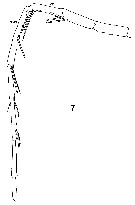 Issued from : W. Giesbrecht in Systematik und Faunistik der Pelagischen Copepoden des Golfes von Neapel und der angrenzenden Meeres-Abschnitte. - Fauna Flora Golf. Neapel, 1892. Atlas von 54 Tafeln. [Taf. 19, Fig.7]. As Leuckartia longicornis. Male: 7, distal segments of left A1.
|
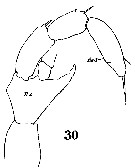 Issued from : W. Giesbrecht in Systematik und Faunistik der Pelagischen Copepoden des Golfes von Neapel und der angrenzenden Meeres-Abschnitte. - Fauna Flora Golf. Neapel, 1892. Atlas von 54 Tafeln. [Taf. 19, Fig.30]. As Leuckartia longicornis. Male: 30, left P5.
|
 Lucicutia longicornis Lucicutia longicornis female: 1 - Characters following not combined : Prosome about 3 times longer than urosome. Cephalosome with slightly projecting and rounded anterior corners and well developed lateral spinous projections; anal somite about as long as wide; caudal rami 11.7 times longer than wide and bowed outwards at base, leaving elliptical space between rami proximally. 2 - P1 with 3-segmented endopod. 3 - Cephalosome without spinous projections. 4 - Genital double-somite symmetrical (dorsal view). 5 - Anal somite much shorter than caudal ramus. 6 - P5 with 3-segmented endopod. 7 - Distal 3 to 4 segments of A1 reaching beyond tip of caudal ramus; body length less than 3 mm. 8 - Prosome 1.3 times longer than urosome. Caudal rami 6 times longer than wide.
|
 Lucicutia longicornis Lucicutia longicornis male: 1 - P1 with 3-segmented endopod. 2 - Cephalosome without lateral projections. 3 - Right A1 reaching 3 to 4 segments beyond tip of caudal rami. 4 - Caudal rami about 6 times longer than wide; basis of left P5 with inner distal corner protruded into single point; exopod of right P5 2-segmented.
| | | | | Compl. Ref.: | | | Wilson, 1942 a (p.192); 1950 (p.256); Østvedt, 1955 (p.15: Table 3, p.76); Grice & Hulsemann, 1967 (p.17); Roe, 1972 (p.277, tabl.1, tabl.2); Björnberg, 1973 (p.343, 387); Deevey & Brooks, 1977 (p.256, tab.2, Station "S"); Carter, 1977 (1978) (p.36); Vives, 1982 (p.293); Kovalev & Shmeleva, 1982 (p.84); Greze & al., 1985 (p.7); Lozano Soldevilla & al., 1988 (p.59); Neumann-Leitao & al., 1999 (p.153, tab.2); Holmes, 2001 (p.17); Kazmi, 2004 (p.228); Khelifi-Touhami & al., 2007 (p.327, Table 1);Neumann-Leitao & al., 2008 (p.799: Tab.II, fig.6); Wishner & al., 2008 (p.163, Table 2, fig.8, oxycline); Gaard & al., 2008 (p.59, Table 1, N Mid-Atlantic Ridge); Brugnano & al., 2010 (p.312, Table 3); Dias & al., 2010 (p.230, Table 1); Uysal & Shmeleva, 2012 (p.909, Table I); Hidalgo & al., 2012 (p.134, Table 2); Zaafa & al., 2014 (p.67, Table I, occurrence); Bonecker & a., 2014 (p.445, Table II: frequency, horizontal & vertical distributions); Zakaria & al., 2016 (p.1, Table 1, Rem.); El Arraj & al., 2017 (p.272, table 2, seasonal composition); Belmonte, 2018 (p.273, Table I: Italian zones) | | | | NZ: | 13 | | |
|
Distribution map of Lucicutia longicornis by geographical zones
|
| | | | | | | | | | Loc: | | | South Africa (E), Trindade Is., Brazil (S, off Rio de Janeiro, off Macaé, off Natal), Cape Verde Is., Mauritania, off Moroccan Atlantic Coast, Canary Is., E Caribbean, Sargasso Sea, off Bermuda (Station "S"), S Strait of Davis (in Jespersen, 1934), S Iceland, Norwegian Sea, off W Ireland, Bay of Biscay, Medit. (M'Diq, Alboran Sea, Gulf of Annaba, Tyrrhenian Sea, W Egyptian coast, N Lebanon Basin), Natal, Arabian Sea, Indian, Philippines, Hawaii, off California, off Galapagos, NE Easter Is., N Chile, off Santiago | | | | N: | 32 | | | | Lg.: | | | (21) F: 2-1,5; M: 1,8-1,4; (47) F: 2-1,8; M: 1,8; (199) F: 1,44; M: 1,37; (402) F: 1,6; {F: 1,44-2,00; M: 1,37-1,80}
| | | | Rem.: | meso & bathypelagic. Overall Depth Range in Sargasso Sea: 0-1000 m (Deevey & Brooks, 1977, Station "S");
Sometimes in the neritic zone.
Boxshall & Halsey (2004, p.135) confirm the presence of paired gonopores in adult females after examination of inseminated females. Inseminated females carry a single ovoid mass of sperm cemented over the median copulatory pore. This probably represents a spermatophoral mass formed by the discharged contents of the spermatophore, rather the spermatophore itself. | | | Last update : 24/10/2022 | |
|
|
 Any use of this site for a publication will be mentioned with the following reference : Any use of this site for a publication will be mentioned with the following reference :
Razouls C., Desreumaux N., Kouwenberg J. and de Bovée F., 2005-2025. - Biodiversity of Marine Planktonic Copepods (morphology, geographical distribution and biological data). Sorbonne University, CNRS. Available at http://copepodes.obs-banyuls.fr/en [Accessed October 14, 2025] © copyright 2005-2025 Sorbonne University, CNRS
|
|
 |
 |










